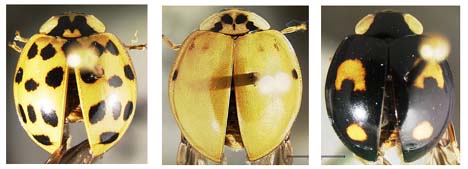Coccinellidae, Coleoptera, Insecta, Arthropoda, Animalia

Additional images: dorsal view of alternate elytral pattern ( small file , large file),( small file , large file),ventral view (small file, large file), tarsus (small file, large file).
Range
Of Japanese origin, first introduced into the Southeastern United States around 1980. Since that time the species has flourished and spread to virtually every state in the continental United States. H. axyridis is widespread in North America with the highest densities on east and west coasts.
Identification
4.6- 11.0 mm long. Form rounded, convex. Elytral coloration is highly variable, the range including red, orange, yellow and black. Can be immaculate or maculate, the maculation being any of the previously mentioned colors. Elytral pattern is also highly variable. Pronotum usually yellow with a distictive "M" shape or a trapezoidal shape in black. Intercoxal process of prosternum broad and flat with fine carina on each side. Middle and hind tibiae each without spurs. Tarsal claw with large subquadrate basal tooth. Postcoxal line incomplete with asymmetrical oblique diving line.
Natural History
Introduced biological control agent that is rapidly enlargening its range. It is an effective control agent in landscaping and agriculture, preying upon aphids, scales, psyllids and other soft-bodied insects. H. axyridis become a nuisance to homeowners due to its overwintering habits of congregating in large numbers in buildings- anywhere that is relatively dark and dry. H. axyridiswill retreat indoors in the fall (October- November), later reappearing out of doors in late winter (February- March) on sunny days.
When alarmed, H. axyridis will secrete a yellow fluid. This is called "reflex bleeding" and it is secreted from the leg joints.
Other Common Names
Halloween lady beetle, Japanese lady beetle, Asian lady beetle.
Literature Cited
Gordon, R. D. 1985. The Coccinellidae (Coleoptera) of America north of Mexico. Journal of the New York Entomological Society 93:1-912.
Page author:
Melissa Kmetz-Barrows. The Evergreen State College, Olympia WA 98505 USA